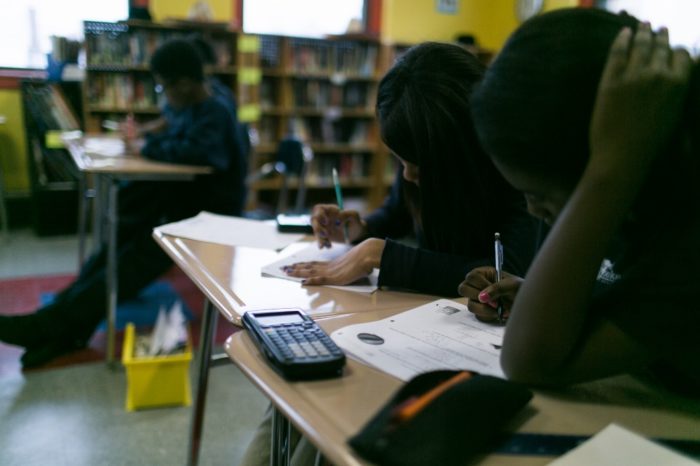Addressing Inequality through K-12 Education in Boston
According to a new Boston Redevelopment Authority (BRA) study cited by The Boston Globe, nearly half of Boston residents make under $35,000 per year. These findings, coupled with a January Brookings Institution report ranking Boston number one nationally in income inequality, paint a worrisome picture of the city. Sadly, many of those left behind in the midst of Boston’s economic boom are low-income minorities.
The underlying issue is that Boston’s schools have not successfully promoted educational opportunity and economic mobility for many of its students. And Boston Public Schools have a particularly high bar to meet because, as the Globe notes, 40 percent of jobs in Massachusetts require a bachelor’s degree compared to 27 percent nationally.
Inequality in K-12 education can be a significant contributor to overall income inequality, and it has proven to be problematic in Boston. The National Assessment of Educational Progress (NAEP) has consistently placed Massachusetts at or near the top of its “Nation’s Report Card” rankings over the last decade, and Boston Public Schools students have consistently scored higher than average on the program’s Trial Urban District Assessment (TUDA) in math and reading, which shows the schools are capable of providing something a whole lot better than many other urban districts across the country. However, given a 70 percent high school graduation rate that is well below state and national averages, far too many Boston students, many of whom are minorities, will not have an opportunity to achieve the American Dream.
Considering that many BPS students are dropping out of high school while others are excelling, it would appear that some schools in the district are performing well while others are failing. This theory is supported by a report put out by Boston Public Schools on 2015 graduation rates, which reveals glaring school-to school discrepancies. Some boast graduation rates over 90 percent, while others are near 50 percent.
Given these inconsistencies, it seems unfair to penalize students for the neighborhoods they live in by forcing them to attend failing schools. Students should be able to attend schools that best serve their own needs and interests, which is why providing the option of charter schools, Catholic schools, METCO (Metropolitan Council for Educational Opportunity), and vocational schools will help more young people succeed.
These additional options have shown great potential in Boston, indicating that there is plenty of room for improvement of the city’s overall educational infrastructure. For example, a nationwide study of urban charter schools conducted by Stanford University’s Center for Research on Education Outcomes (CREDO) revealed across-the-board improvements in math and reading performance for students at Boston charter schools compared with their district school counterparts.
Charter schools, it must be noted, are just one of the options that should be considered. Catholic schools have also produced superior academic results, as Cara Stillings Candal outlined in a paper for Pioneer, titled, “Be Not Afraid.” Additionally, the METCO program has helped fight education inequality along with racial and economic segregation by providing students living in low-income Boston neighborhoods with the opportunity to attend schools in suburban areas. As Pioneer described in its 2011 paper, “METCO Merits More,” the program has dealt with repeated budget cuts in spite of the benefits it provides to needy students.
Finally, while vocational schools have served as inspiring success stories in other parts of the state, Boston lags behind. As Pioneer Executive Director Jim Stergios has noted, Boston’s Madison Park Technical-Vocational High School, the city’s only public vocational school, has been mired in a cycle of poor performance, due largely to an ineffective oversight structure. Fixing Madison Park, as former Mayor Thomas Menino pledged to do, would provide Boston students with exciting new opportunities, and could create yet another vital tool for combatting educational inequality.
Mayor Marty Walsh has made addressing income inequality a priority, stressing the issue in his most recent State of the City address. Mayor Walsh’s main initiatives for tackling inequality involve on-the-job training and education for low-income workers, emphasizing that the best way to take on the problems facing Boston is through education. That’s a good start but more is needed.
As of October 2015, there are about 34,000 students on waiting lists for Massachusetts charter schools, 19,749 of whom are in Boston. More than a third of Boston charter school students go on to earn a college degree within six years of graduation, compared with just 15 percent of their Boston Public Schools counterparts. With impressive statistics like that, why not give more children a chance at upward mobility?
A recent Pioneer Institute study showed that a 5 percent increase in spending could eliminate urban charter school waitlists. And as district schools compete with charters for students, there is little doubt that the result will be better education for all public school students.
Michael Weiner is a student at Northeastern University studying International Affairs. He is working as a Research and Programs Assistant at Pioneer Institute through the Northeastern Co-op program. Find Michael on Twitter at: @michaelgweiner



